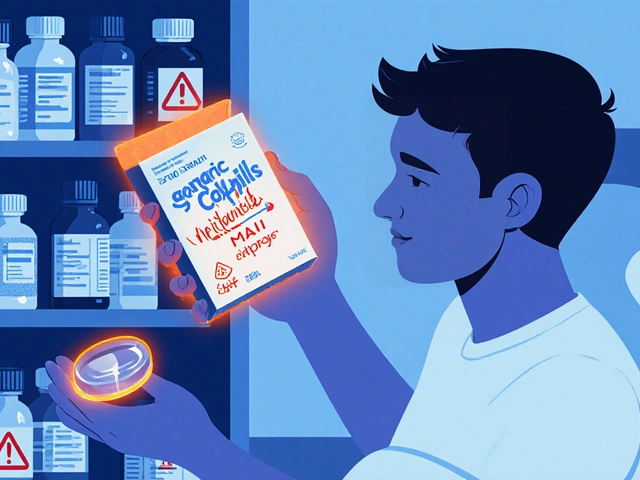Severe Bleeding on Medications: What to Watch For and How to Respond in an Emergency
Bleeding Risk Calculator
Blood Thinner Bleeding Risk Assessment
Based on your medical history and current conditions, this tool estimates your risk of severe bleeding while taking blood thinners. A high-risk score means you should take extra precautions and monitor closely.
When you take a blood thinner-whether it’s warfarin, apixaban, rivaroxaban, or dabigatran-you’re trading one risk for another. These drugs prevent deadly clots from forming in your heart or legs, but they also make it harder for your body to stop bleeding. For many, this trade-off works. For others, it leads to a terrifying reality: uncontrolled bleeding that can turn life-threatening in hours.
Why Blood Thinners Cause Severe Bleeding
Blood thinners don’t actually make your blood thinner. They interfere with the clotting process. Warfarin blocks vitamin K, which your liver needs to make clotting factors. DOACs like apixaban and rivaroxaban directly inhibit specific proteins in the clotting cascade. Antiplatelet drugs like clopidogrel stop platelets from sticking together. All of these actions reduce clotting-but they also mean that when you cut yourself, bleed internally, or suffer trauma, your body struggles to seal the damage.The risk isn’t theoretical. In the first year of treatment, about 3.1% of atrial fibrillation patients on DOACs experience a bleeding event. That number jumps to 6.5% if you have two or more risk factors: age over 75, kidney problems, a history of bleeding, or taking another blood thinner or NSAID like ibuprofen. The first 90 days are the most dangerous. Six out of ten bleeding episodes happen in this window.
Recognizing the Warning Signs
Most people don’t realize they’re bleeding until it’s serious. Unlike a cut on your finger, internal bleeding doesn’t always show up right away. Here’s what to watch for:- Prolonged nosebleeds-lasting more than 10 minutes despite pressure
- Red or brown urine-signaling bleeding in the kidneys or bladder
- Black, tarry stools-a classic sign of bleeding in the stomach or intestines
- Unexplained bruising-large, painful bruises without injury
- Coughing or vomiting blood-bright red or coffee-ground-like material
- Severe headaches-especially if sudden and unlike any you’ve had before
- Dizziness, weakness, or vision changes-signs your brain or body isn’t getting enough oxygen from blood loss
- Joint pain or swelling-after even minor injury, could mean bleeding into the joint
- Excessive menstrual bleeding-soaking through a pad or tampon every hour
- Persistent bleeding from minor cuts-that won’t stop after 15 minutes of pressure
A 2023 Mayo Clinic survey found that 42% of patients on anticoagulants had at least one bleeding episode in their first year. Of those, 28% didn’t realize it was serious until they were already dizzy or fainting. That delay can cost you your life.
Who’s at Highest Risk?
Not everyone on blood thinners bleeds. But some people are far more vulnerable.- Age over 80: Bleeding risk jumps from 1.25 per 100 treatment-years under 60 to 4.33 per 100 for those over 80.
- Chronic kidney disease: Poor kidney function increases bleeding risk by more than double. Dosing adjustments are critical.
- History of bleeding: If you’ve had a GI bleed or brain hemorrhage before, your risk of another is 4.2 times higher.
- Multiple medications: Taking aspirin, NSAIDs, or another anticoagulant doubles your bleeding risk.
- Supratherapeutic drug levels: Even if you take the right dose, your body may absorb too much-especially if you’re elderly or have low body weight.
One study found that 58% of bleeding events occurred in patients on low-dose DOACs-not the full dose. Why? Because doctors often reduce doses for older or frail patients, but don’t always check blood levels. The result: some patients end up with too much drug in their system, even on a "lower" dose.

What to Do If You Start Bleeding
Time matters. Every minute counts when you’re losing blood internally.- Stop what you’re doing. Sit or lie down. Don’t try to power through.
- Call 999 or go to the nearest emergency department. Don’t wait. Don’t call your GP first. Emergency teams are trained to handle this.
- Bring your medication list. Include the name, dose, and time of your last pill. If you have your anticoagulant card (given to you at start of treatment), bring it.
- Do NOT take more medication. If you’re bleeding, taking another dose could make it worse.
- Do NOT take aspirin, ibuprofen, or naproxen. These make bleeding worse.
At the hospital, they’ll check your blood pressure, heart rate, and hemoglobin. They’ll do a CT scan if they suspect brain bleeding. For DOACs, they may use a rapid test to measure drug levels-something now available in many UK hospitals since early 2024. For warfarin, they’ll check your INR. If it’s above 4.5, you’re at high risk.
Reversal Agents: The Lifesavers
There are drugs that can undo the effect of blood thinners-fast.- Idarucizumab reverses dabigatran. One vial (5g) costs around $3,500 in the US, and it works in minutes.
- Andexanet alfa reverses rivaroxaban, apixaban, and edoxaban. A full treatment course costs over $12,500.
- Prothrombin complex concentrate (PCC) and vitamin K are used for warfarin reversal.
These aren’t magic bullets. They’re expensive, not always available, and only work if given in time. In the UK, hospitals have protocols for accessing them-but delays still happen. That’s why early recognition is so critical.
What Your Doctor Should Do Before Prescribing
A responsible doctor won’t just hand you a prescription and say "take this." They should:- Use the HAS-BLED score to assess your bleeding risk. A score of 3 or higher means you need extra safety measures.
- Check your kidney function with a creatinine clearance test before starting.
- Review all your other medications-especially NSAIDs, SSRIs, and antibiotics.
- Give you a written list of bleeding symptoms and emergency instructions.
- Schedule follow-up within 1-2 weeks after starting, especially if you’re over 75.
- For warfarin users: monitor INR weekly for the first month, then monthly if stable.
Studies show that patients who get a 15-20 minute education session at the start of treatment are 34% less likely to delay going to the ER when bleeding happens.

Real Stories, Real Consequences
One patient on apixaban noticed black stools for three days. He thought it was "just indigestion." By the time he went to the ER, he’d lost enough blood to need two units. He spent five days in hospital. Another, after hip surgery, had a nosebleed that lasted 45 minutes. She didn’t realize it was dangerous until she felt dizzy. Her hemoglobin dropped to 7.8 g/dL-down from 13.5. She needed a transfusion. These aren’t rare. On patient forums, 68% of anticoagulant users say they didn’t recognize bleeding symptoms early enough. Many waited hours-sometimes over six-before seeking help.What’s Changing in 2025?
The field is evolving. In January 2024, the FDA approved the first point-of-care test to measure DOAC levels in minutes-not days. Now, clinics can check if you’re over-dosed without sending blood to a lab. New drugs are coming. Milvexian and asundexian, two experimental anticoagulants in Phase III trials, show 20-25% less bleeding than current drugs-while still preventing strokes. If approved, they could change the game. Also, the NHS and NICE are updating guidelines to recommend routine DOAC level testing for patients over 75, those with kidney issues, and anyone who’s had a bleed before.Bottom Line: Know the Signs, Act Fast
Blood thinners save lives. But they come with a silent danger: bleeding you might not notice until it’s too late. The key isn’t avoiding these drugs-it’s understanding them.If you’re on one, know your symptoms. Keep your medication list handy. Tell someone close to you what to look for. And if you think you’re bleeding-don’t wait. Don’t hope it gets better. Go to the emergency room. Your life depends on it.





13 Comments
Denny Sucipto
November 17 2025Man, I didn't realize how sneaky bleeding could be until my grandma went through this. She thought her black stools were just "old food" - turned out she was bleeding internally for three days. Got to the ER just in time. If you're on blood thinners, don't ignore weird stuff. Even if it feels small. Better safe than sorry.
Holly Powell
November 18 2025It's statistically indefensible to generalize DOAC risk profiles without stratifying by renal clearance, CYP3A4/5 polymorphism status, and concomitant P-glycoprotein modulation. The Mayo Clinic data cited lacks multivariate adjustment for polypharmacy burden - a critical confounder. Also, the term 'blood thinner' is a misnomer; it's a prothrombotic state modulation agent. Please consult pharmacokinetic literature before posting.
Emanuel Jalba
November 19 2025THIS IS WHY WE CAN'T HAVE NICE THINGS 😭💊
Doctors just hand out these death pills like candy. My uncle died because they didn't check his INR. Now his wife is alone. And the hospital charged $12k to reverse it??!! 😡
Who profits from this? Pharma? The system is rigged. I'm taking turmeric now. 🌿
Heidi R
November 20 2025You're all missing the point. The real issue is that patients aren't educated enough. Doctors skip the counseling. It's negligence. Period.
Brenda Kuter
November 20 2025They’re hiding the truth. I read a whistleblower report - the FDA knew DOACs cause more brain bleeds than warfarin but didn’t warn the public. They’re protecting profits. I have the PDF. Someone needs to expose this. 🕵️♀️💥
Shaun Barratt
November 21 2025While the post contains a wealth of clinically relevant information, it is marred by inconsistent punctuation and a lack of formal citation for several statistical claims. For instance, the 68% figure from patient forums lacks a source, and the term 'coffee-ground-like material' is colloquial and imprecise. A more rigorous presentation would enhance credibility.
Iska Ede
November 21 2025Oh so now we’re supposed to be heroes who can diagnose internal bleeding before we pass out? Thanks for the tip, Doc. Meanwhile, my insurance won’t cover the test that tells me if I’m overdosed… but will cover the ambulance ride after I collapse. 🙃
Gabriella Jayne Bosticco
November 22 2025I'm in the UK and we've had the DOAC testing kits in our local hospital since last year. It's a game-changer. My mum had a bleed last Christmas - they checked her levels in 20 minutes. She was out in 48 hours. Knowledge saves lives. Don't panic, but don't ignore the signs either.
Sarah Frey
November 23 2025Thank you for this comprehensive and compassionate overview. The emphasis on early recognition and immediate emergency response is critical. I have shared this with my elderly patients and their families. Education, paired with accessible reversal agents, remains the cornerstone of safe anticoagulation therapy.
Katelyn Sykes
November 24 2025My dad was on apixaban after his stroke and he ignored the bruising for weeks. Then one day he couldn't stand up. Turned out he had a massive hematoma in his thigh. He's fine now but I swear if we'd known about the joint pain sign earlier…
Just tell someone. Don't wait. Even if you think you're being dramatic. You're not.
Gabe Solack
November 24 2025Big shoutout to the folks who actually get the education session at the start - it’s a lifesaver. My pharmacist spent 20 minutes with me, gave me a card, and even called my mom to make sure she knew what to watch for. That’s the kind of care that makes a difference 🙌
Also, yes, the reversal drugs are expensive. But if you're in the ER and they give you idarucizumab? You’ll be thanking them. No shame in that.
Yash Nair
November 24 2025USA always make everything complicated. In India we just use aspirin and pray. No fancy tests. No $12k drugs. We dont need all this science. Just faith and simple medicine. Why you waste money on this? Your system broken.
Bailey Sheppard
November 25 2025Thank you for writing this. I’ve been on rivaroxaban for two years now and I didn’t know half of this. I’m printing it out and putting it on my fridge. I told my wife what to look for. We’re not scared - we’re prepared. That’s the difference.